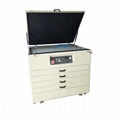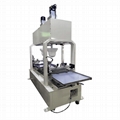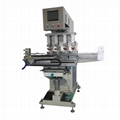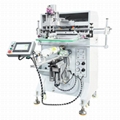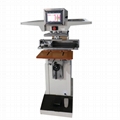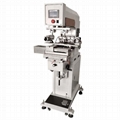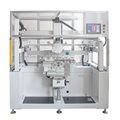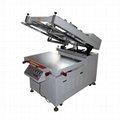| Model: | PS-3050PVHS |
|---|---|
| Brand: | KC |
| Origin: | Made In China |
| Category: | Industrial Supplies / Plate Making & Printing Machine |
| Label: | servo screen printer , servo silk printer , servo screen machine |
| Price: |
US $7954
/ pic
|
| Min. Order: | 1 pic |
| Last Online:30 Apr, 2025 |
High-precision in-and-out workbench screen printer:
Servo in-and-out workbench
• Precise positioning and conveying: The servo in-and-out workbench relies on high-precision servo motor drive to achieve precise positioning and smooth conveying of screen-printed workpieces. In the screen printing process, it can accurately deliver the workpiece to the screen printing area according to the preset program with minimal error. For example, when printing electronic components and other workpieces that require strict position accuracy, it can ensure that they are in the best printing starting position to ensure the accuracy of subsequent printed patterns.
• Flexible adaptation to different workpieces: The workbench can be flexibly adjusted according to the size and shape of the workpiece. Whether it is a larger flat glass, metal sheet, or a small plastic sheet, through the corresponding parameter setting or mechanical structure adjustment, it can adapt to the corresponding workpiece, stably carry and convey them in and out of the screen printer, greatly broadening the scope of application of the equipment and meeting diverse production needs.
• Efficient production guarantee: The servo system allows the in-and-out speed of the workbench to be adjusted as needed. When printing in batches, the in-and-out speed can be reasonably set according to factors such as the complexity of the printed pattern and the drying time of the ink, so as to achieve fast and accurate workpiece transportation, speed up the overall production rhythm, and help to efficiently complete large-scale screen printing tasks and improve production efficiency.
Touch screen operation
• Easy and intuitive operation: The touch screen operation interface is concise and clear, and many complex functions and parameter settings are integrated on the visual panel. Operators can easily complete the setting of key parameters such as screen printing speed, scraper pressure, and the distance between the screen and the workpiece by simply touching the corresponding icons and buttons on the screen. The operation process is simple and easy to understand, just like operating common smart electronic devices. Novices can also quickly get started and operate proficiently, which greatly reduces the operating threshold.
• Real-time status monitoring: The touch screen can also display various working status information of the screen printer in real time, such as the number of current printings, the position and speed of the servo in and out of the workbench, the suction of the suction workbench, the running status of the linear guide rail, and the position of the upper and lower servos of the screen. Operators can use this to promptly discover abnormal conditions in the operation of the equipment and quickly make corresponding treatments to ensure that the screen printing work can be carried out continuously and stably, thereby improving the reliability of the equipment.
Suction table
• Steady adsorption of workpieces: The suction table can firmly adsorb the flat workpiece to be screen-printed on the table by generating negative pressure. Whether the workpiece is made of thin paper, soft plastic film, or hard metal sheet, it can be stably fixed, effectively avoiding the displacement of the workpiece during the screen printing process, laying a solid foundation for precise printing and ensuring the position accuracy of the printed pattern, which is crucial for high-precision screen printing.
• Keep the workpiece flat: For some workpieces that may have slight warping or unevenness, the adsorption effect of the suction table can keep it as flat as possible during printing. In this way, the screen plate can fit better with the surface of the workpiece, which is conducive to the uniform transfer of ink through the screen to the workpiece, ensuring the integrity and clarity of the printed pattern, and improving the quality of screen printing.
Linear guide control
• Precision movement guarantee: Linear guides control the movement of related components (such as screens, etc.) so that they run along precise linear trajectories in a plane. This precise movement method can effectively avoid problems such as shaking, offset or vibration of components during movement, thereby ensuring that the ink can be evenly and accurately distributed on the workpiece. Especially when printing fine lines and tiny patterns, the high-precision movement provided by linear guide control can greatly improve the printing accuracy and ensure the high-quality presentation of the pattern.
• High repeatability and stability: Linear guides have the characteristics of high repeatability. During multiple printing processes, related components can accurately return to the same position, ensuring that the position and quality of the pattern printed each time are highly consistent. This is extremely important for mass production of high-precision printed products, such as high-end electronic product panel printing, optical lens marking and other tasks, which can ensure the stability and consistency of product quality and meet the strict requirements of high-precision printing.
Screen up and down servo
• Precise height adjustment: The screen up and down servo system can accurately control the vertical lifting and lowering of the screen. The distance between the screen and the workpiece surface can be precisely adjusted according to the thickness of different workpieces, the requirements of the printed pattern and other factors to ensure that the ink is evenly transferred at the appropriate spacing, avoiding problems such as too thick or too thin ink and unclear patterns caused by improper distance, and achieving high-quality screen printing effects.
• Flexible adaptation to multi-color printing: When performing multi-color overprinting, the up and down servo system of the screen plays a key role. It can ensure that the screen of each color can accurately drop to the predetermined height, accurately fit the workpiece for printing, and smoothly rise after completing one color printing to prepare for the next color printing, ensuring the overprint accuracy between the colors, so that the printed pattern is rich in color, clear in layers, and without deviation, meeting the needs of high-precision multi-color printing.
The overall embodiment and advantages of high-precision printing
• Collaboration of various links: precise conveying of servo in and out of the workbench, precise control of touch screen operation, stable workpiece handling of the suction workbench, precise movement of linear guide control, and fine height adjustment of the upper and lower servos of the screen. These functional links work together to ensure the high-precision printing performance of the screen printer from all aspects, from the entry and exit and fixation of the workpiece to the movement of the screen and the transfer of ink.
• Wide application value: With its high-precision screen printing capability, this screen printer can be widely used in many fields with extremely high requirements for printing accuracy, such as electronics, optics, precision machinery, and high-end printed product production. In the electronics industry, it can print fine circuits and logos for circuit boards; in the optical field, it can be used for marking and decoration of products such as lenses and display screens; in precision machinery manufacturing, it can print high-precision scales and logos on the surface of parts, etc., providing reliable and high-quality printing solutions for the appearance decoration and content presentation of various products, improving the added value and market competitiveness of products, and strongly promoting the improvement of product quality in related industries.
In summary, this high-precision flat screen printer with many advanced functions has significant advantages in the field of flat screen printing. It can provide strong guarantees for the high-precision printing needs of various industries and meet diverse market demands.
|
PS-3050PVHS Servo Flat precision screen printing machine with movement vacuum table //Structure |
|
|
Working table |
Vacuum working table, Size: 300*500mm |
|
Actions |
Up-down of screen plate |
|
To be printed |
|
|
Squeegee stroke |
Adjust the Limited switch |
|
Squeegee and screen plate control |
High precision linear guideway |
|
PS-3050PVH Servo Flat screen printing machine with movement vacuum table //Usage and characters |
|
|
Guide |
|
|
Application |
|
|
PS-3050PVHS Servo Flat screen printing Machine with movement vacuum table//Parameters |
|
|
Technical parameters |
|
|
Works supply |
|
|
Package parameters |
|
|
|
|
H.S.CODE |
8443192190 |
|
Certificate |
CE |
|
PS-3050PVHS Servo Flat screen printing Machine with movement vacuum table //Advantage |
|
|
Function |
|
| Application: | To further improve the accuracy of the flat screen printing machine, in addition to using a linear guide mechanism for guiding control, the main action can also be controlled by a servo motor. The main action of the flat screen printing machine is the up and down motion of the screen and the left and right motion of the scraper. The movement control of the motor can be digitally set through the programmable controller, and the screen plate can be adjusted up and down, and the scraper can be fine-tuned. For products with many product specifications and frequent parameter adjustments, the servo screen printing machine is easy to operate. Sex is also praised by the operator. The safety of the precision flat screen printing machine mainly considers whether the arm that is too late to be removed will be accidentally injured when the screen is pressed down. Now, two aspects of the design will be paid attention to: one is to add safety gratings at both ends of the workbench. Once the arm enters, the machine will It will stop automatically. The other is to install an automatic entry and exit workbench. After the product is printed, the workbench will automatically move out. After placing the product, the workbench will automatically enter the printing position to complete the printing. The sliding movement of the workbench can also be controlled by pneumatic or electric control. and servo motor control. |
|---|---|
